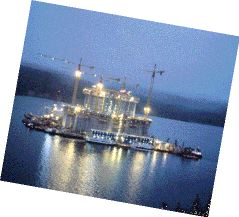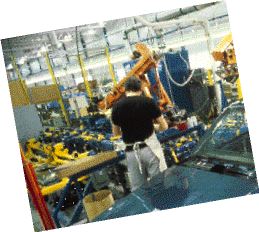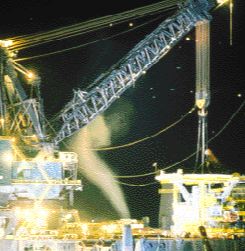Atlantic
Canada:
by Maggie Marwah
Whether it's the Internet, infrastructure or information
technology, Canada's East Coast has a high-tech connection for everyone.
A student examining the evolution of work could do worse than investigate what's happening in Atlantic Canada. Long revered for its rugged seafaring traditions, the country's easternmost part has positioned itself to welcome the new millennium at the forefront of The Information Revolution.
From one of the world's most sophisticated telecommunications systems to Canada's first completely wired university, the efforts have paid dividends for businesses and a work force that searches for that perennially elusive commodity: jobs.
"The old economic paradigm of centralized production close to consumers hasn't been kind to Atlantic Canada, because we're reasonably far from major markets," says David Amirault, chief economist of the Atlantic Provinces Economic Council. "However, information technology will allow, has already allowed, Atlantic Canada to become a player."
Just how much of a player? When the council, a public policy and research organization, teamed up with Statistics Canada last year to survey the region's software developers and computer services industries, they found a sector that recorded approximately US$183 million in revenues -- growing at a stunning annual rate of 62 percent. Those numbers represent unlimited potential for this gentle corner of Canada, whose 2.4 million are finding an electronic economic foothold.
"It's not a surprise as to why information technology has taken hold in Atlantic Canada; it actually makes sense," says Amirault. "The barriers that used to be there -- transport costs, information costs, communications costs and the like -- are quickly declining, and Atlantic Canada can compete."
 |
| Nova Scotia-based IMP Group is more closely associated with the aerospace industry, but recently won a $1.5 million contract to supply 900 offshore immersion suits to the Hibernia oil exploration project, including those used on the drilling platform and in helicopter transportation. |
|
But even as they eye the future with get-go confidence, the four provinces that comprise Atlantic Canada -- New Brunswick, Nova Scotia, Prince Edward Island and Newfoundland, and Labrador -- have not turned their backs on the past. For many business leaders, the challenge has been to marry the old resource-based industries with the new high-tech ways.
So, by necessity and by desire, Canada's Atlantic region finds itself straddling the old and the new -- and feeling quite comfortable with it. Ever mindful of the need for jobs and economic growth, provincial governments strive to fuel confidence by creating a business-friendly culture and by encouraging new ways of building roads to the future.
|
Business- Minded New
Brunswick
New Brunswick is building a new kind of highway -- the kind critical to business prosperity in the 20th century's twilight.
NBTel, for example, has built one of the world's most advanced and reliable telecommunications systems, a completely digitized system backboned by thousands of miles of fiber-optic cables. The result has been a boom in call centers -- bureaus that handle businesses' worldwide telephone communications. Thirty companies (and counting) have set up shop in New Brunswick in the past five years, among them Xerox Canada, Purolator Courier and hotel franchiser HFS Inc.
|
They, in turn, draw related businesses. Last year, Genesys Labs of San Bruno, Calif., struck a joint venture with Bruncor Inc. to set up a facility in Saint John, New Brunswick's largest city. The purpose: to develop call center software for the international market. It's part of the provincial government's long-term strategy to attract increasingly more sophisticated players in the information technology field, to create what Ian Cavanagh calls "a living lab."
"Come to New Brunswick, do development here, access the technology, access customers who have chosen to establish call centers here, who want to be on the leading edge," says Cavanagh, part of the initiative and now Genesys Canada's general manager. "The end result is to develop things faster, in an environment where it's economically attractive, and to have a 'test bed' -- then take it out and sell it to the rest of the world."
|
 |
| Sweden's Volvo assembles the 850, its most popular car, at a Halifax plant. The factory produces five- and four-door versions of the luxury car for all Canadian and U.S. Northeast markets. |
|
For Genesys Labs, a world leader in the fast-growing computer telephony integration (CTI) sector, coming to New Brunswick was simply logical, Cavanagh says. CTI is about using computer power that essentially instructs the telephone network how to do things more intelligently; and for Genesys, the next step up was Bruncor-owned NBTel, a recognized leader in the call center industry and a telephone industry innovator.
"It's complementary when it comes to the relationship: They have the knowledge to add in specific areas, and so do NBTel and the employees we hire here," Cavanagh says of the partnership. "It won't make sense to do otherwise."
|
Greater Fredericton:
New Brunswick's
High-Tech Hotbed
It's little wonder that New Brunswick Premier Frank McKenna calls Greater Fredericton "a hotbed of high-tech industries." More than 50 percent of New Brunswick's IT industry calls the Fredericton region its home.
In addition to an ever-growing array of homegrown successes, the roster of Greater Fredericton's IT firms includes branch plants of such high-profile corporations as CGI, SHL, Unisys and DMR. As well, the region boasts advanced telecommunications facilities, a skilled, bilingual work force and low business costs -- not to mention a tremendous lifestyle.
First Class Systems Development Corp., Canada's largest courseware developer, scouted across the country for its development center, eventually settling on Greater Fredericton. As company President Ken Reimer explains, "In choosing a location, our priorities were to find an active high-tech community, a well-educated labor pool and a thriving business environment. And that is just what we found."
Likewise, 3C Canada, a subsidiary of 3C Ltd. of Hong Kong, recognized the advantages of this region and opened its first manufacturing facility outside the Far East in Greater Fredericton. As a company specializing in the development, manufacturing and distribution of digital switches, 3C was searching for a place to do research and development on wireless telecom equipment. "We were looking for a place where we could foster partnership for research and development with university and private enterprise," explains 3C Canada General Manager S.B. Chan. Greater Fredericton had exactly what 3C was looking for.
|
|
It helps that any company conducting business in New Brunswick (pop. 762,500) does so against the backdrop of a pro-business mindset of a Liberal government elected 10 years ago with a self-styled mission: to spruce up the province's image. Today, New Brunswick has one of Canada's most competitive business tax structures.
Nova Scotia: Digital
Denizens Do Business
To some telecommunications business observers, it may seem that Nova Scotia plays second fiddle to its more aggressive northwest neighbor, New Brunswick. But make no mistake: When it comes to the Information Age, Nova Scotians are no slouches.
Canada's largest Internet service provider, i-Star, was born here in the most populous of the Atlantic provinces. with 942,800 residents. It's home to the country's first online newspaper, The Daily News of Halifax. In fact, the province boasts Canada's highest per-capita Internet users, aided no doubt by a dozen universities, including totally wired Acadia. Last year, the small liberal arts school in the pretty town of Wolfville in the province's Annapolis Valley armed all freshmen with computer notebooks.
A study of the work force in the provincial capital of Halifax, the region's self-touted cultural and economic heart, found that knowledge workers outnumber production workers three to one. Most of the province's 4,000 researchers are in the Halifax area, where fully 16.8 percent of the labor force have university degrees. And, oh yes, the city has more per-capita Ph.D.'s than anywhere else in Canada.
Tapping into this brainy market are the likes of Keane Inc. The Boston-based software services company this year began setting up an application development center in downtown Halifax. Recruitment ads were clear: They were after the city's ready and able supply of university grads.
|
And there's more to this Canadian safe haven than a high-tech edge. Besides the technically minded work force, Walters points to an "unbeatable quality of life" -- affordable housing, safe schools, lakes, beaches, 12 golf clubs and five yacht clubs -- and a sophisticated telecommunications infrastructure into which MT&T, the province's primary phone company, invests $110 million annually.
|
Cyberspace aside, Nova Scotia also boasts earthly links to the rest of the world. Ice-free ports in Halifax, Sydney and Point Tupper are a full day's sailing closer to Europe than any other North American main port. By air, the province is two hours closer to Europe than New York or Toronto. Long-time transplants to the province in the heavy manufacturing and resource sectors -- Michelin, Volvo and Stora, among them -- know the advantages.
Swedish pulp and paper giant Stora cited competitive transportation costs in announcing plans last year to spend $475 million on a new plant at Port Hawkesbury, N.S., where it already has a pulp and newsprint mill. One of the largest investments ever made by a European company in the North America forestry sector, the new state-of-the-art plant will produce 350,000 tons of uncoated super-calendered paper used in magazines and ad inserts.
|
 |
| Currently building Canada's new fleet of coastal patrol vessels, Halifax Shipyards Ltd., is one of many companies owned by New Brunswick's Irving family. The Irving conglomerate includes holdings in almost every major industry doing business in Atlantic Canada and New England. |
|
In the years ahead, there'll be a more physical link between Nova Scotia and U.S. markets: a pipeline for offshore Sable gas. A consortium led by Mobil Oil Canada plans to spend $1.5 billion to build a collection and transportation system to bring about 5 trillion cubic feet (150 million cubic meters) of natural gas ashore. Once on land, a separate company will transport the gas to markets, mainly in the United States, via a $730 million pipeline.
Prince Edward Island:
Bridging the Gap
The economy of Prince Edward Island (PEI) is also acutely attuned to 21st century business bridges.
|
Construction of a giant bridge linking the tiny island to the mainland powered the province's economy through 1995 and 1996, allowing it to lead the region and most of Canada in growth.
When Confederation Bridge officially opens this spring, on schedule and on budget, a century of dreaming and debating comes to a close -- as does some big-time spending. During the three years of construction, about $613 million was spent by the private backers of Strait Crossing Joint
Venture, a consortium comprising France's GTMI, the Netherlands' Ballast-Nedam and Calgary's Strait Crossing Inc.
|
| Courtesy of the city of St. John's |
 |
| In St. John's, historic houses overlook craggy cliffs that plummet into the Atlantic Ocean, part of the Newfoundland capital's natural appeal. |
|
To show for its money, the partners will have a state-of-technology steel and concrete structure spanning eight miles ( 13 km.) of the Northumberland Strait, and a well-oiled fabrication yard awaiting new tenants at Borden near Summerside, one of the province's two main urban centers. (The other is the provincial capital of Charlottetown, known as the cradle of Canadian Confederation.) Add to that a skilled work force -- peak employment was 2,500 -- and PEI hope hinges on the efforts of the consortium and the provincial government to attract new projects.
"We have the infrastructure in place for construction, a jetty at the site and a deep-water port, so it's ideal for shipping," boasts Krista Jenkins, Strait Crossing coordinator of public information.
 |
| Oil, ahoy: Two decades of searching for offshore oil becomes a reality at year-end 1997, with the scheduled production of the Hibernia field off St. John's, Newfoundland. Some $3.7 billion was spent on building its one-of-a-kind production platform. |
|
The province's water-locked geography hasn't, however, been a limitation where information technology is concerned. Prince Edward Island (pop. 137,300) has also managed to sell itself as an attractive locale for call centers, including one that handles a national tech-support line for Internet provider HookUp Communications, and another that provides 24-hour service for Canon office products. Among the Island's lures: no provincial sales taxes on inbound 800 calls or outbound long-distance telephone usage over 250,000 minutes a year.
|
Add to the mix an Internet design company, Digital Island, whose PEI Web site earned it a place among PC Computing magazine's best 1,001 Internet sites in the world. Among Digital Island's other customers: Yankee Publishing of Dublin, N.H., producers of the Old Farmer's Almanac and The Yankee Traveler.
Newfoundland and Labrador:
Land of Discovery
Perhaps more than any other area, Canada's most easterly province has been forced by economic necessity to embrace the new technological age. The decline earlier this decade of its mainstay northern cod fishery has meant the inevitable demise of a centuries-old way of out-port life -- and, simultaneously, a wake-up call for the 570,700 people who call Newfoundland and Labrador home.
Government and business leaders have responded by thinking big. The mega-project is king in this resource-rich area: Hibernia, Voisey's Bay, Terra Nova, Whiffen Head and Argentia are just some of the names linked with millions, sometimes billions, of development dollars. And behind all is a high-tech way of doing things.
 |
| While Atlantic Canada's beauty reflects its seafaring traditions, the region boasts one of the world's most sophisticated telecommunications systems and Canada's first completely wired university. |
|
This year, as the province throws a big party to mark the 500th anniversary of John Cabot's arrival to its shores, Newfoundlanders and Labradorians will have much more to celebrate. After two decades of promise and hype, offshore oil becomes a reality at the end of 1997, with the scheduled production of the Hibernia field about 225 miles (360 km.) southeast of St. John's, Newfoundland's capital city. Some $3.7 billion was spent on building of its one-of-a-kind production platform -- $1.6 billion in Newfoundland itself, where the massive structure was constructed.
|
"It's the beginning of offshore development for this region -- it's just the beginning," enthuses the Hibernia project's John Percic. "It will put in place the infrastructure that will help support ongoing developments."
Meanwhile, on land, sparsely populated mainland Labrador has been undergoing a mineral rush. But the anticipated find of Voisey's Bay is unparalleled: The deposit holds upward of an estimated 150 million tons of nickel, copper and cobalt ores worth $22 billion. Giant nickel processor Inco plans a $800 million development of a mine and mill in Labrador and a smelter complex at Argentia, former home of a U.S. military base on the island of Newfoundland.
|
Developers are shooting for a production date of 1998, with year 2000 projections calling for annual production of 270 million pounds (122 kg.) of nickel, 200 million pounds (90 kg.) of copper and a significant amount of cobalt.
"This decade is really a transition decade for the Newfoundland economy," says Atlantic Provinces Economic Council economist Amirault. "By the year 2000, the provincial economy will look a hell of a lot different than it looked in 1990.
|
 |
| Confederation Bridge will span eight miles (13 km.) and connect Prince Edward Island with Canada's mainland when it officially opens in spring 1997. The fixed link's total cost was a $840 million, but its economic benefits will be immense. |
|
"Newfoundlanders will certainly be in an enviable position, having created two brand-new sectors -- oil and gas and mineral processing -- two very large sectors by any stretch of the imagination. And by that point, there may be a recovered cod fishery."
-- Maggie Marwah is a freelance writer and editor based
in Nova Scotia.

Wired for Business
Canada's Competitive Cost Advantage
Atlantic Canada
Quebec
Ontario
The West

A Site Selection Special Feature






